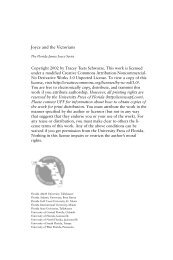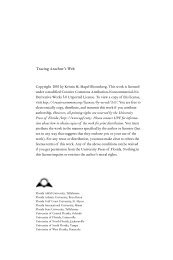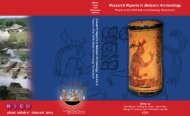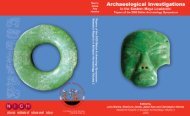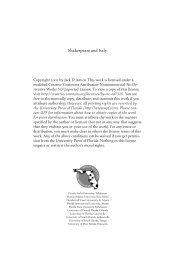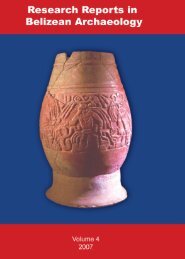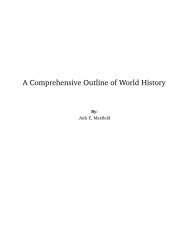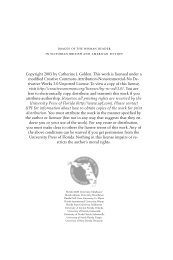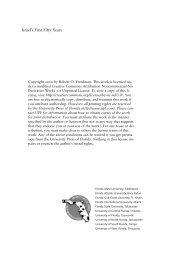- Page 1 and 2:
Bernard Shaw’s Remarkable Religio
- Page 3 and 4:
Bernard Shaw’s Remarkable Religio
- Page 5 and 6:
For Jalma, who made it possible.
- Page 7 and 8:
Contents Foreword by R. F. Dietrich
- Page 9 and 10:
Foreword “I believe because it is
- Page 11 and 12:
Preface Foreword xi The seed of thi
- Page 13 and 14:
Preface xiii hope to reach some of
- Page 15 and 16:
Introduction Preface xv Here we hav
- Page 17 and 18:
Introduction xvii the facts asked i
- Page 19 and 20:
o I Foundations of Faith
- Page 21 and 22:
Unity 1 A Creed for Living A Faith
- Page 23 and 24:
A Creed for Living 5 ticism toward
- Page 25 and 26:
A Creed for Living 7 posed to the i
- Page 27 and 28:
A Creed for Living 9 ally—at the
- Page 29 and 30:
A Creed for Living 11 tions of deat
- Page 31 and 32:
A Creed for Living 13 For many the
- Page 33 and 34:
A Creed for Living 15 fying faith.
- Page 35 and 36:
A Creed for Living 17 We have inesc
- Page 37 and 38:
Realism 19 Thus, I blush to add, yo
- Page 39 and 40:
Realism 21 evenhanded. Tyndall pres
- Page 41 and 42:
Realism 23 no scoundrels. A similar
- Page 43 and 44:
Realism 25 sage and confuse and dis
- Page 45 and 46:
Realism 27 tific materialism is utt
- Page 47 and 48:
Realism 29 of his fellows) is natur
- Page 49 and 50:
Realism 31 to be tied down to textb
- Page 51 and 52:
Realism 33 as they do not denote an
- Page 53 and 54:
Realism 35 women who disparage home
- Page 55 and 56:
Realism 37 woven out of words and i
- Page 57 and 58:
Consistency 3 The Will and Its Resp
- Page 59 and 60:
The Will and Its Responsibilities 4
- Page 61 and 62:
The Will and Its Responsibilities 4
- Page 63 and 64:
The Will and Its Responsibilities 4
- Page 65 and 66:
The Will and Its Responsibilities 4
- Page 67 and 68:
The Will and Its Responsibilities 4
- Page 69 and 70:
The Will and Its Responsibilities 5
- Page 71 and 72:
The Will and Its Responsibilities 5
- Page 73 and 74:
The Will and Its Responsibilities 5
- Page 75 and 76:
The Will and Its Responsibilities 5
- Page 77 and 78:
The Will and Its Responsibilities 5
- Page 79 and 80:
The Will and Its Responsibilities 6
- Page 81 and 82:
The Will and Its Responsibilities 6
- Page 83 and 84:
The Will and Its Responsibilities 6
- Page 85 and 86:
The Will and Its Responsibilities 6
- Page 87 and 88:
The Will and Its Responsibilities 6
- Page 89 and 90:
II o A Guide to Art and Life
- Page 91 and 92:
Dramatic Realism 4 A Playwright’s
- Page 93 and 94:
Illusionism Is Not Realism A Playwr
- Page 95 and 96:
Contradictions in Scientific Realis
- Page 97 and 98:
A Playwright’s Progress 79 view,
- Page 99 and 100:
A Playwright’s Progress 81 horror
- Page 101 and 102:
A Playwright’s Progress 83 My pla
- Page 103 and 104:
A Playwright’s Progress 85 disast
- Page 105 and 106:
A Playwright’s Progress 87 Shaw i
- Page 107 and 108:
A Playwright’s Progress 89 jectiv
- Page 109 and 110:
A Playwright’s Progress 91 suprem
- Page 111 and 112:
A Playwright’s Progress 93 certai
- Page 113 and 114:
A Playwright’s Progress 95 In cal
- Page 115 and 116:
A Playwright’s Progress 97 pishly
- Page 117 and 118:
A Playwright’s Progress 99 too
- Page 119 and 120:
A Playwright’s Progress 101 woman
- Page 121 and 122:
A Playwright’s Progress 103 focus
- Page 123 and 124:
A Playwright’s Progress 105 Candi
- Page 125 and 126:
A Playwright’s Progress 107 Shaw
- Page 127 and 128:
A Playwright’s Progress 109 strug
- Page 129 and 130:
A Playwright’s Progress 111 Not t
- Page 131 and 132:
A Playwright’s Progress 113 Amiab
- Page 133 and 134:
A Playwright’s Progress 115 find
- Page 135 and 136:
A Playwright’s Progress 117 sexua
- Page 137 and 138:
A Playwright’s Progress 119 culti
- Page 139 and 140:
A Playwright’s Progress 121 ing t
- Page 141 and 142:
The Organic and the Didactic 5 Majo
- Page 143 and 144:
Major Barbara 125 fundamental confl
- Page 145 and 146:
Major Barbara 127 picture, but Majo
- Page 147 and 148:
Major Barbara 129 acters in a play,
- Page 149 and 150:
Major Barbara 131 goes his own way,
- Page 151 and 152:
Major Barbara 133 have you ever sav
- Page 153 and 154:
Major Barbara 135 gibbet, while Chr
- Page 155 and 156:
Major Barbara 137 Moral responsibil
- Page 157 and 158:
Major Barbara 139 motto is “Unash
- Page 159 and 160:
Major Barbara 141 (this is explicit
- Page 161 and 162:
Major Barbara 143 eryone else in th
- Page 163 and 164:
Major Barbara 145 which he himself
- Page 165 and 166:
Ethics 6 Ethics, Economics, and Gov
- Page 167 and 168:
Ethics, Economics, and Government 1
- Page 169 and 170:
Ethics, Economics, and Government 1
- Page 171 and 172:
Ethics, Economics, and Government 1
- Page 173 and 174:
Ethics, Economics, and Government 1
- Page 175 and 176:
Ethics, Economics, and Government 1
- Page 177 and 178:
Ethics, Economics, and Government 1
- Page 179 and 180:
Ethics, Economics, and Government 1
- Page 181 and 182:
Ethics, Economics, and Government 1
- Page 183 and 184:
Ethics, Economics, and Government 1
- Page 185 and 186:
Ethics, Economics, and Government 1
- Page 187 and 188:
Ethics, Economics, and Government 1
- Page 189 and 190:
Ethics, Economics, and Government 1
- Page 191 and 192:
Ethics, Economics, and Government 1
- Page 193 and 194:
Ethics, Economics, and Government 1
- Page 195 and 196:
Ethics, Economics, and Government 1
- Page 197 and 198:
Ethics, Economics, and Government 1
- Page 199 and 200:
Ethics, Economics, and Government 1
- Page 201 and 202:
III o God and Science The Marriage
- Page 203 and 204:
7 The Marriage of Science and Relig
- Page 205 and 206:
The Marriage of Science and Religio
- Page 207 and 208:
The Marriage of Science and Religio
- Page 209 and 210:
The Marriage of Science and Religio
- Page 211 and 212: The Marriage of Science and Religio
- Page 213 and 214: The Marriage of Science and Religio
- Page 215 and 216: The Marriage of Science and Religio
- Page 217 and 218: The Marriage of Science and Religio
- Page 219 and 220: The Marriage of Science and Religio
- Page 221 and 222: The Marriage of Science and Religio
- Page 223 and 224: The Marriage of Science and Religio
- Page 225 and 226: Can Science Be Purged of Materialis
- Page 227 and 228: The Marriage of Science and Religio
- Page 229 and 230: The Marriage of Science and Religio
- Page 231 and 232: The Marriage of Science and Religio
- Page 233 and 234: The Marriage of Science and Religio
- Page 235 and 236: The Marriage of Science and Religio
- Page 237 and 238: The Marriage of Science and Religio
- Page 239 and 240: The Marriage of Science and Religio
- Page 241 and 242: The Marriage of Science and Religio
- Page 243 and 244: The Marriage of Science and Religio
- Page 245 and 246: The Marriage of Science and Religio
- Page 247 and 248: The Marriage of Science and Religio
- Page 249 and 250: The Marriage of Science and Religio
- Page 251 and 252: IV o A Peroration
- Page 253 and 254: 8 Catching Up with Shaw Shaw procla
- Page 255 and 256: Catching Up with Shaw 237 would pre
- Page 257 and 258: Catching Up with Shaw 239 to variou
- Page 259 and 260: Catching Up with Shaw 241 rialists
- Page 261: Catching Up with Shaw 243 Such goal
- Page 265 and 266: Notes 247 difficult to obtain, but
- Page 267 and 268: Notes 249 turbing, these attitudes
- Page 269 and 270: Works by Shaw Works Cited Notes 251
- Page 271 and 272: Works Cited 253 Shaw and Ibsen: Ber
- Page 273 and 274: Works Cited 255 ———. Introduc
- Page 275 and 276: Works Cited 257 McRory, Desmond J.
- Page 277 and 278: Works Cited 259 Weismann, August. E
- Page 279 and 280: Aquinas, Thomas, 52 Archer, William
- Page 281 and 282: Saussure, Ferdinand de, 74 Schopenh



